The Cellulose Loading and Silylation Effects on the Mechanical Properties of Epoxy Composites: Insights from Classical and Reactive Molecular Dynamics Simulations
Abstract
1. Introduction
2. Materials and Test Methods
2.1. Molecular Dynamics Simulation
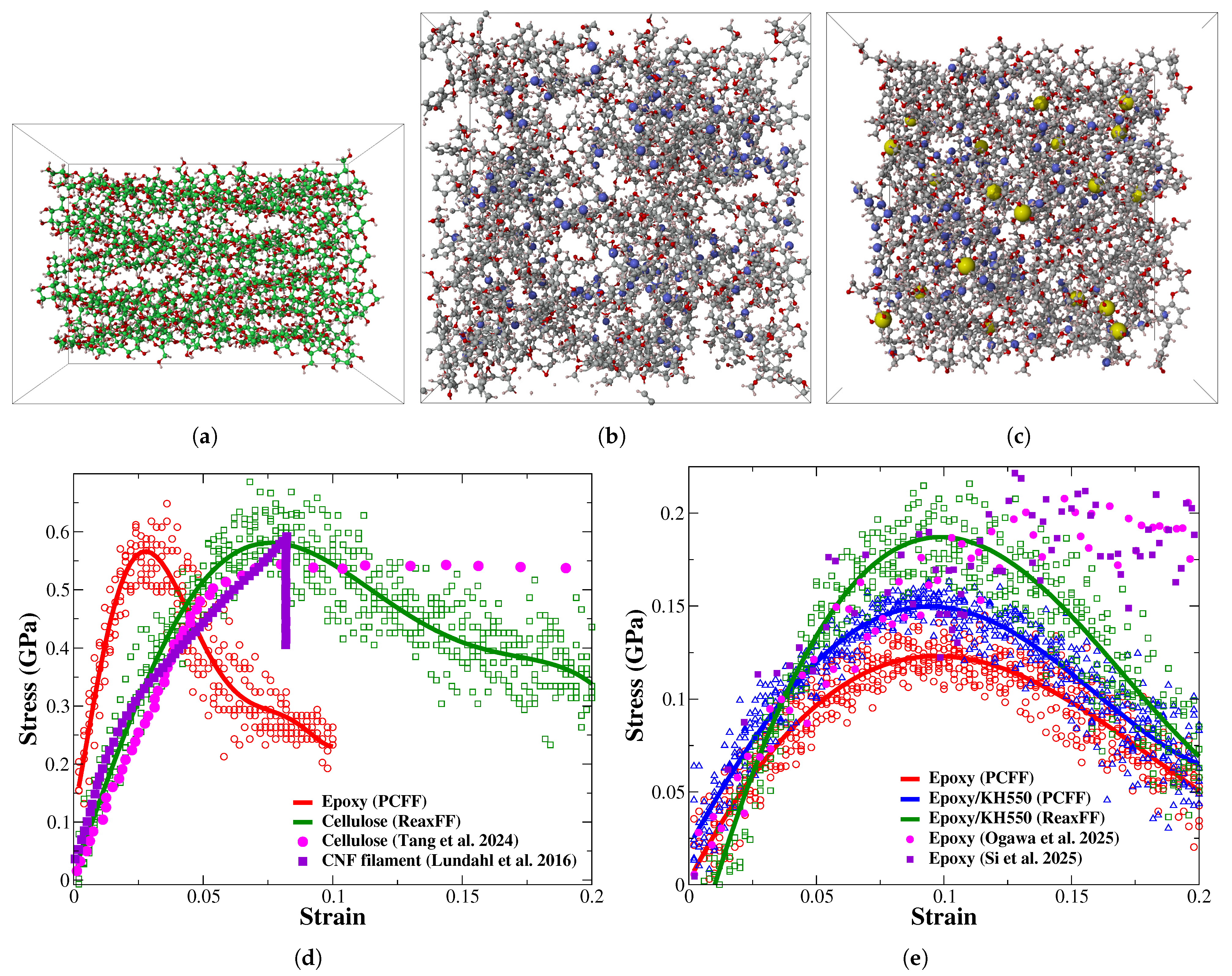
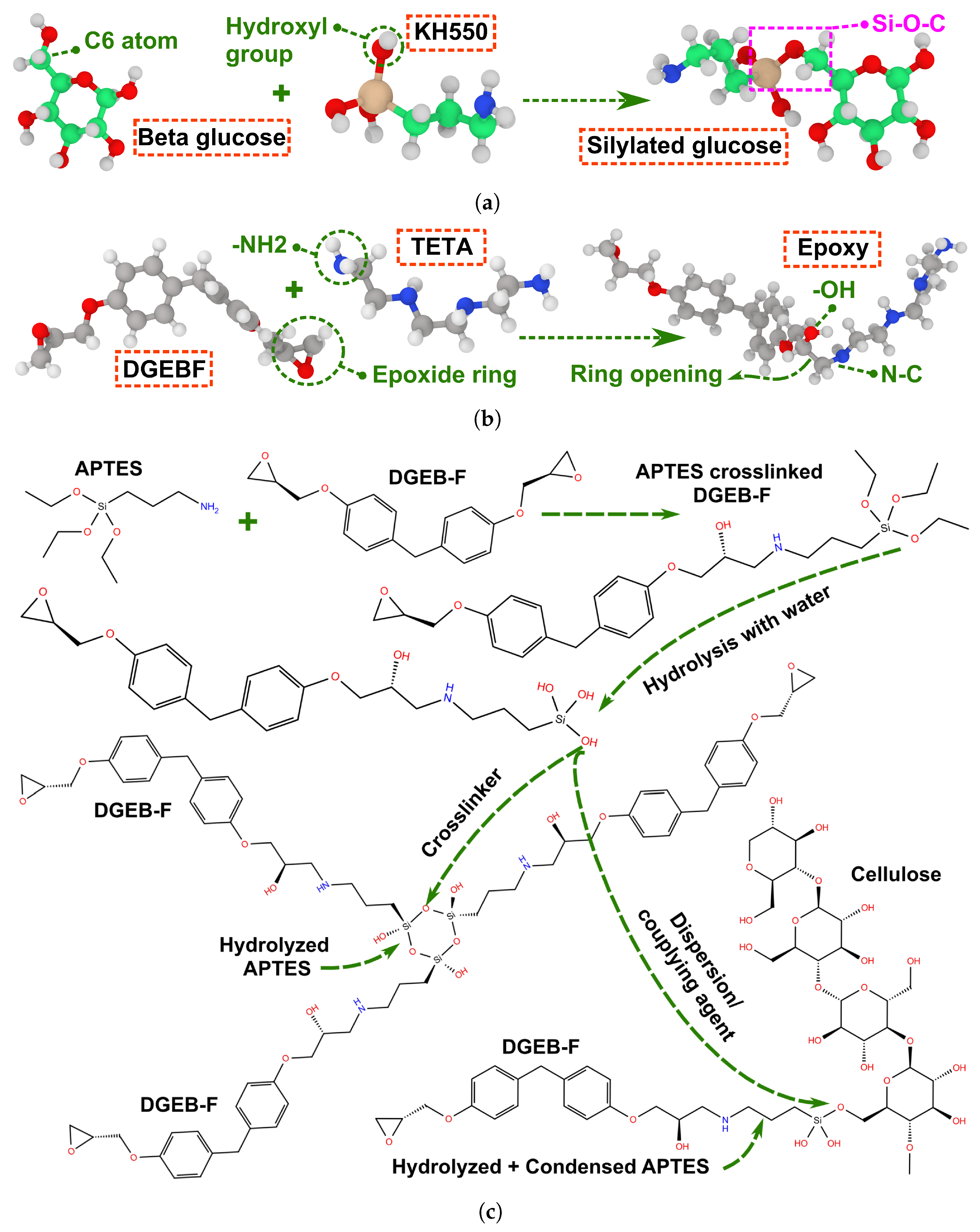
2.2. Reinforcing Epoxy with Silylated Cellulose
3. Results and Discussion
3.1. The Effect of Silylation Treatment on the Interfacial Adhesion
3.2. The Structural Reinforcing Effect of Cellulose at High Loadings
3.3. The Effect of Cellulose Silylation on the Mechanical Properties
4. Conclusions
Author Contributions
Funding
Data Availability Statement
Conflicts of Interest
References
- Ren, Z.; Guo, R.; Zhou, X.; Bi, H.; Jia, X.; Xu, M.; Wang, J.; Cai, L.; Huang, Z. Effect of amorphous cellulose on the deformation behavior of cellulose composites: Molecular dynamics simulation. RSC Adv. 2021, 11, 19967–19977. [Google Scholar] [CrossRef] [PubMed]
- Jakob, M.; Mahendran, A.R.; Gindl-Altmutter, W.; Bliem, P.; Konnerth, J.; Müller, U.; Veigel, S. The strength and stiffness of oriented wood and cellulose-fibre materials: A review. Prog. Mater. Sci. 2022, 125, 100916. [Google Scholar] [CrossRef]
- Sirviö, J.A.; Lakovaara, M. A fast dissolution pretreatment to produce strong regenerated cellulose nanofibers via mechanical disintegration. Biomacromolecules 2021, 22, 3366–3376. [Google Scholar] [CrossRef] [PubMed]
- Subbotina, E.; Montanari, C.; Olsén, P.; Berglund, L.A. Fully bio-based cellulose nanofiber/epoxy composites with both sustainable production and selective matrix deconstruction towards infinite fiber recycling systems. J. Mater. Chem. A 2022, 10, 570–576. [Google Scholar] [CrossRef]
- Adusumali, R.B.; Reifferscheid, M.; Weber, H.; Roeder, T.; Sixta, H.; Gindl, W. Mechanical properties of regenerated cellulose fibres for composites. Macromol. Symp. 2006, 244, 119–125. [Google Scholar] [CrossRef]
- Low, I.; McGrath, M.; Lawrence, D.; Schmidt, P.; Lane, J.; Latella, B.; Sim, K. Mechanical and fracture properties of cellulose-fibre-reinforced epoxy laminates. Compos. Part A Appl. Sci. Manuf. 2007, 38, 963–974. [Google Scholar] [CrossRef]
- Mader, A.; Kondor, A.; Schmid, T.; Einsiedel, R.; Müssig, J. Surface properties and fibre-matrix adhesion of man-made cellulose epoxy composites – Influence on impact properties. Compos. Sci. Technol. 2016, 123, 163–170. [Google Scholar] [CrossRef]
- Hameed, N.; Bavishi, J.; Parameswaranpillai, J.; Salim, N.; Joseph, J.; Madras, G.; Fox, B. Thermally flexible epoxy/cellulose blends mediated by an ionic liquid. RSC Adv. 2015, 5, 52832–52836. [Google Scholar] [CrossRef]
- Saba, N.; Mohammad, F.; Pervaiz, M.; Jawaid, M.; Alothman, O.; Sain, M. Mechanical, morphological and structural properties of cellulose nanofibers reinforced epoxy composites. Int. J. Biol. Macromol. 2017, 97, 190–200. [Google Scholar] [CrossRef]
- Yusuf, J.; Sapuan, S.; Rashid, U.; Ilyas, R.; Hassan, M. Thermal, mechanical, and morphological properties of oil palm cellulose nanofibril reinforced green epoxy nanocomposites. Int. J. Biol. Macromol. 2024, 278, 134421. [Google Scholar] [CrossRef]
- Masoodi, R.; El-Hajjar, R.; Pillai, K.; Sabo, R. Mechanical characterization of cellulose nanofiber and bio-based epoxy composite. Mater. Des. (1980–2015) 2012, 36, 570–576. [Google Scholar] [CrossRef]
- Zhang, D.; Huang, Y. Dispersion characterizations and adhesion properties of epoxy composites reinforced by carboxymethyl cellulose surface treated carbon nanotubes. Powder Technol. 2022, 404, 117505. [Google Scholar] [CrossRef]
- Adil, S.; Kumar, B.; Panicker, P.S.; Pham, D.H.; Kim, J. High-performance green composites made by cellulose long filament-reinforced vanillin epoxy resin. Polym. Test. 2023, 123, 108042. [Google Scholar] [CrossRef]
- Tüfekci, M. Nonlinear dynamic mechanical and impact performance assessment of epoxy and microcrystalline cellulose-reinforced epoxy. Polymers 2024, 16, 3284. [Google Scholar] [CrossRef] [PubMed]
- Nair, S.S.; Dartiailh, C.; Levin, D.B.; Yan, N. Highly toughened and transparent biobased epoxy composites reinforced with cellulose nanofibrils. Polymers 2019, 11, 612. [Google Scholar] [CrossRef]
- Nair, S.S.; Kuo, P.Y.; Chen, H.; Yan, N. Investigating the effect of lignin on the mechanical, thermal, and barrier properties of cellulose nanofibril reinforced epoxy composite. Ind. Crops Prod. 2017, 100, 208–217. [Google Scholar] [CrossRef]
- Nissilä, T.; Hietala, M.; Oksman, K. A method for preparing epoxy-cellulose nanofiber composites with an oriented structure. Compos. Part A Appl. Sci. Manuf. 2019, 125, 105515. [Google Scholar] [CrossRef]
- Kim, H.C.; Panicker, P.S.; Kim, D.; Adil, S.; Kim, J. High-strength cellulose nanofiber/graphene oxide hybrid filament made by continuous processing and its humidity monitoring. Sci. Rep. 2021, 11, 13611. [Google Scholar] [CrossRef]
- Alamri, H.; Low, I. Mechanical properties and water absorption behaviour of recycled cellulose fibre reinforced epoxy composites. Polym. Test. 2012, 31, 620–628. [Google Scholar] [CrossRef]
- Voicu, S.I.; Thakur, V.K. Aminopropyltriethoxysilane as a linker for cellulose-based functional materials: New horizons and future challenges. Curr. Opin. Green Sustain. Chem. 2021, 30, 100480. [Google Scholar] [CrossRef]
- Liu, F.; Huang, L.; Wang, B.; Hu, Z.; Zhang, C.; Lu, F. Molecular dynamics simulation study of the mechanical properties of silane coupling agent-enhanced glass fiber/epoxy resin interfaces. Polym. Compos. 2025, 46, 13466–13479. [Google Scholar] [CrossRef]
- Khanjanzadeh, H.; Behrooz, R.; Bahramifar, N.; Gindl-Altmutter, W.; Bacher, M.; Edler, M.; Griesser, T. Surface chemical functionalization of cellulose nanocrystals by 3-aminopropyltriethoxysilane. Int. J. Biol. Macromol. 2018, 106, 1288–1296. [Google Scholar] [CrossRef] [PubMed]
- Wang, X.; Guo, J.; Ren, H.; Jin, J.; He, H.; Jin, P.; Wu, Z.; Zheng, Y. Research progress of nanocellulose-based food packaging. Trends Food Sci. Technol. 2024, 143, 104289. [Google Scholar] [CrossRef]
- Kono, H.; Uno, T.; Tsujisaki, H.; Matsushima, T.; Tajima, K. Nanofibrillated bacterial cellulose modified with (3-aminopropyl)trimethoxysilane under aqueous conditions: Applications to poly(methyl methacrylate) fiber-reinforced nanocomposites. ACS Omega 2020, 5, 29561–29569. [Google Scholar] [CrossRef]
- Lu, T.; Jiang, M.; Jiang, Z.; Hui, D.; Wang, Z.; Zhou, Z. Effect of surface modification of bamboo cellulose fibers on mechanical properties of cellulose/epoxy composites. Compos. Part B Eng. 2013, 51, 28–34. [Google Scholar] [CrossRef]
- Rajan, R.; Rainosalo, E.; Thomas, S.P.; Ramamoorthy, S.K.; Zavašnik, J.; Vuorinen, J.; Skrifvars, M. Modification of epoxy resin by silane-coupling agent to improve tensile properties of viscose fabric composites. Polym. Bull. 2018, 75, 167–195. [Google Scholar] [CrossRef]
- Rajan, R.; Rainosalo, E.; Ramamoorthy, S.K.; Thomas, S.P.; Zavašnik, J.; Vuorinen, J.; Skrifvars, M. Mechanical, thermal, and burning properties of viscose fabric composites: Influence of epoxy resin modification. J. Appl. Polym. Sci. 2018, 135, 46673. [Google Scholar] [CrossRef]
- Bamer, F.; Ebrahem, F.; Markert, B. Athermal mechanical analysis of Stone-Wales defects in two-dimensional silica. Comput. Mater. Sci. 2019, 163, 301–307. [Google Scholar] [CrossRef]
- Bamer, F.; Ebrahem, F.; Markert, B.; Stamm, B. Molecular mechanics of disordered solids. Arch. Comput. Methods Eng. 2023, 30, 2105–2180. [Google Scholar] [CrossRef]
- Mostafavi, S.; Bamer, F.; Markert, B. Molecular dynamics simulation of interface atomic diffusion in ultrasonic metal welding: Effect of crystal orientation and sliding velocity. Int. J. Adv. Manuf. Technol. 2022, 118, 2339–2353. [Google Scholar] [CrossRef]
- Liu, T.; Li, K.; Zhou, A.; Yu, Z.; Qin, R.; Zou, D. Atomic insight into the functionalization of cellulose nanofiber on durability of epoxy nanocomposites. Nano Res. 2023, 16, 3256–3266. [Google Scholar] [CrossRef]
- Al-Maharma, A.; Markert, B.; Bamer, F. Silylation Treatment of C/Sic Reinforced Cellulose Nanocomposites to Mitigate the Adverse Impact of Moisture on the Mechanical Performance. Available online: https://ssrn.com/abstract=4855671 (accessed on 18 April 2025). [CrossRef]
- Wang, Y.; Kiziltas, A.; Blanchard, P.; Walsh, T.R. Probing functionalized cellulose/polypropylene interfacial properties at the molecular scale. ACS Sustain. Chem. Eng. 2025, 13, 16325–16334. [Google Scholar] [CrossRef]
- Ruan, H.O.; Wang, W.H.; Umemoto, T.; Song, Y.Z.; Kumada, A.; Sato, M. Tailoring multi-scale interactions at resin-layer interfaces for simultaneous enhancement of electrical and mechanical strength in aramid paper laminates. Compos. Part A Appl. Sci. Manuf. 2025, 198, 109146. [Google Scholar] [CrossRef]
- Wu, H.; Zhang, J.; Song, Y.; Jia, D.; Sun, G.; Wang, C. Effect of alkali treatment and silane functionalization on cellulose fibers: Experimental investigation, mechanism and molecular dynamics simulation. Appl. Surf. Sci. 2026, 716, 164716. [Google Scholar] [CrossRef]
- Plimpton, S. Fast parallel algorithms for short-range molecular dynamics. J. Comput. Phys. 1995, 117, 1–19. [Google Scholar] [CrossRef]
- Design, M. Material Exploration Design Analysis (MedeA) Release 3.6. 2023. Available online: https://www.materialsdesign.com (accessed on 24 December 2024).
- Vashisth, A.; Ashraf, C.; Zhang, W.; Bakis, C.E.; van Duin, A.C.T. Accelerated ReaxFF simulations for describing the reactive cross-linking of polymers. J. Phys. Chem. A 2018, 122, 6633–6642. [Google Scholar] [CrossRef]
- Newsome, D.A.; Sengupta, D.; Foroutan, H.; Russo, M.F.; van Duin, A.C.T. Oxidation of silicon carbide by O2 and H2O: A ReaxFF reactive molecular dynamics study, Part I. J. Phys. Chem. C 2012, 116, 16111–16121. [Google Scholar] [CrossRef]
- Zhang, X.; Tschopp, M.A.; Horstemeyer, M.F.; Shi, S.Q.; Cao, J. Mechanical properties of amorphous cellulose using molecular dynamics simulations with a reactive force field. Int. J. Model. Identif. Control 2013, 18, 211–217. [Google Scholar] [CrossRef]
- Mileo, P.G.M.; Krauter, C.M.; Sanders, J.M.; Browning, A.R.; Halls, M.D. Molecular-scale exploration of mechanical properties and interactions of poly(lactic acid) with cellulose and chitin. ACS Omega 2023, 8, 42417–42428. [Google Scholar] [CrossRef]
- Haque, E.; Kalaitzidou, K.; Wu, X. A molecular dynamics study of the effects of silane and cellulose nanocrystals at a glass fiber and epoxy interphase. Cellulose 2024, 31, 11243–11258. [Google Scholar] [CrossRef]
- Jiang, K.; Yan, Z.; Fang, W.; Zhang, Y. Molecular dynamics simulation on tensile behavior of cellulose at different strain rates. Adv. Mater. Sci. Eng. 2023, 2023, 7890912. [Google Scholar] [CrossRef]
- Uppal, N.; Pappu, A.; Gowri, V.K.S.; Thakur, V.K. Cellulosic fibres-based epoxy composites: From bioresources to a circular economy. Ind. Crops Prod. 2022, 182, 114895. [Google Scholar] [CrossRef]
- Anderson, O.L. A simplified method for calculating the debye temperature from elastic constants. J. Phys. Chem. Solids 1963, 24, 909–917. [Google Scholar] [CrossRef]
- Zhao, H.; Chang, A.; Wang, Y. Structural, elastic, and electronic properties of cubic perovskite BaHfO3 obtained from first principles. Phys. B Condens. Matter 2009, 404, 2192–2196. [Google Scholar] [CrossRef]
- Chen, W.; Lickfield, G.C.; Yang, C.Q. Molecular modeling of cellulose in amorphous state. Part I: Model building and plastic deformation study. Polymer 2004, 45, 1063–1071. [Google Scholar] [CrossRef]
- Si, J.S.; Wu, N.; Wen, M.J.; Chen, D.P.; He, Y.L.; Zhang, J.W.; Duan, K. Reactive machine learning force field for crosslinked epoxy. Chin. J. Polym. Sci. 2025, 43, 1761–1773. [Google Scholar] [CrossRef]
- Ogawa, M.; Morimura, A.; Haba, I.; Yonezu, A. Coarse-grained molecular dynamics simulations of nano-deformation behavior of epoxy adhesives’ interface during atomic force microscopy (AFM) mechanical testing. Polymer 2025, 320, 128071. [Google Scholar] [CrossRef]
- Gong, Y.; Zhang, L.; He, J.; Liu, B.; Wang, L.; Ao, Y.; Liu, Y.; Shang, L. Improving processability and mechanical properties of epoxy resins with biobased flame retardants. Polym. Int. 2024, 73, 646–657. [Google Scholar] [CrossRef]
- Hobbiebrunken, T.; Fiedler, B.; Hojo, M.; Tanaka, M. Experimental determination of the true epoxy resin strength using micro-scaled specimens. Compos. Part A Appl. Sci. Manuf. 2007, 38, 814–818. [Google Scholar] [CrossRef]
- Lundahl, M.J.; Klar, V.; Wang, L.; Ago, M.; Rojas, O.J. Spinning of cellulose nanofibrils into filaments: A review. Ind. Eng. Chem. Res. 2017, 56, 8–19. [Google Scholar] [CrossRef]
- Tang, J.; Wu, L.; Fan, X.; Dong, X.; Li, X.; Xie, Y.; Li, J.; Rao, J.; Li, T.; Gan, W. Superstrong, sustainable, origami wood paper enabled by dual-phase nanostructure regulation in cell walls. Sci. Adv. 2024, 10, eado5142. [Google Scholar] [CrossRef]
- Cho, J.; Luo, J.; Daniel, I. Mechanical characterization of graphite/epoxy nanocomposites by multi-scale analysis. Compos. Sci. Technol. 2007, 67, 2399–2407. [Google Scholar] [CrossRef]
- Santmarti, A.; Liu, H.W.; Herrera, N.; Lee, K.Y. Anomalous tensile response of bacterial cellulose nanopaper at intermediate strain rates. Sci. Rep. 2020, 10, 15260. [Google Scholar] [CrossRef]
- Research, D.E.S. Schrödinger Release 2021-2: Desmond Molecular Dynamics System; Schrodinger: New York, NY, USA, 2021; Available online: www.schrodinger.com (accessed on 20 March 2025).
- Wang, X.; Tang, C.; Wang, Q.; Li, X.; Hao, J. Selection of optimal polymerization degree and force field in the molecular dynamics simulation of insulating paper cellulose. Energies 2017, 10, 1377. [Google Scholar] [CrossRef]
- Tang, Y.; Tang, C.; Hu, D.; Gui, Y. Effect of aminosilane coupling agents with different chain lengths on thermo-mechanical properties of cross-linked epoxy resin. Nanomaterials 2018, 8, 951. [Google Scholar] [CrossRef]
- Zhang, L.; Chen, L.; Huang, W.; Rao, X.; Lu, Y.; Zhang, W.; Pan, S.; Yu, M. Molecular dynamics simulation of epoxy resin properties at different C=N contents. AIP Adv. 2023, 13, 095013. [Google Scholar] [CrossRef]
- Watowich, S.J.; Meyer, E.S.; Hagstrom, R.; Josephs, R. A stable, rapidly converging conjugate gradient method for energy minimization. J. Comput. Chem. 1988, 9, 650–661. [Google Scholar] [CrossRef]
- Sayadi, S.; Brouillette, F. Silylation of phosphorylated cellulosic fibers with an aminosilane. Carbohydr. Polym. 2024, 343, 122500. [Google Scholar] [CrossRef]
- Martínez, L.; Andrade, R.; Birgin, E.G.; Martínez, J.M. PACKMOL: A package for building initial configurations for molecular dynamics simulations. J. Comput. Chem. 2009, 30, 2157–2164. [Google Scholar] [CrossRef] [PubMed]
- Sathish Kumar, R.; Durgam Muralidharan, N. Mechanical characteristics study of chemically modified kenaf fiber reinforced epoxy composites. J. Nat. Fibers 2022, 19, 2457–2467. [Google Scholar] [CrossRef]
- Suarsana, I.K.; Suryawan, I.; Suardana, N.; Winaya, S.; Soenoko, R.; Suyasa, B.; Sunu, P.W.; Rasta, I. Flexural strength of hybrid composite resin epoxy reinforced stinging nettle fiber with silane chemical treatment. AIMS Mater. Sci. 2021, 8, 185–199. [Google Scholar] [CrossRef]
- Barari, B.; Ellingham, T.K.; Qamhia, I.; Pillai, K.M.; El-Hajjar, R.; Turng, L.S.; Sabo, R. Mechanical characterization of scalable cellulose nano-fiber based composites made using liquid composite molding process. Compos. Part B Eng. 2016, 84, 277–284. [Google Scholar] [CrossRef]
- Barari, B.; Omrani, E.; Dorri Moghadam, A.; Menezes, P.L.; Pillai, K.M.; Rohatgi, P.K. Mechanical, physical and tribological characterization of nano-cellulose fibers reinforced bio-epoxy composites: An attempt to fabricate and scale the ‘Green’ composite. Carbohydr. Polym. 2016, 147, 282–293. [Google Scholar] [CrossRef] [PubMed]
- Yang, J.P.; Chen, Z.K.; Yang, G.; Fu, S.Y.; Ye, L. Simultaneous improvements in the cryogenic tensile strength, ductility and impact strength of epoxy resins by a hyperbranched polymer. Polymer 2008, 49, 3168–3175. [Google Scholar] [CrossRef]
- Yang, J.; He, X.; Wang, H.; Liu, X.; Lin, P.; Yang, S.; Fu, S. High-toughness, environment-friendly solid epoxy resins: Preparation, mechanical performance, curing behavior, and thermal properties. J. Appl. Polym. Sci. 2020, 137, 48596. [Google Scholar] [CrossRef]
- Mi, X.; Liang, N.; Xu, H.; Wu, J.; Jiang, Y.; Nie, B.; Zhang, D. Toughness and its mechanisms in epoxy resins. Prog. Mater. Sci. 2022, 130, 100977. [Google Scholar] [CrossRef]
- Ansari, F.; Galland, S.; Johansson, M.; Plummer, C.J.; Berglund, L.A. Cellulose nanofiber network for moisture stable, strong and ductile biocomposites and increased epoxy curing rate. Compos. Part A Appl. Sci. Manuf. 2014, 63, 35–44. [Google Scholar] [CrossRef]
- Rangaraj, R.; Sathish, S.; Mansadevi, T.L.D.; Supriya, R.; Surakasi, R.; Aravindh, M.; Karthick, A.; Mohanavel, V.; Ravichandran, M.; Muhibbullah, M.; et al. Investigation of weight fraction and alkaline treatment on Catechu Linnaeus/Hibiscus cannabinus/Sansevieria Ehrenbergii plant fibers-reinforced epoxy hybrid composites. Adv. Mater. Sci. Eng. 2022, 2022, 4940531. [Google Scholar] [CrossRef]
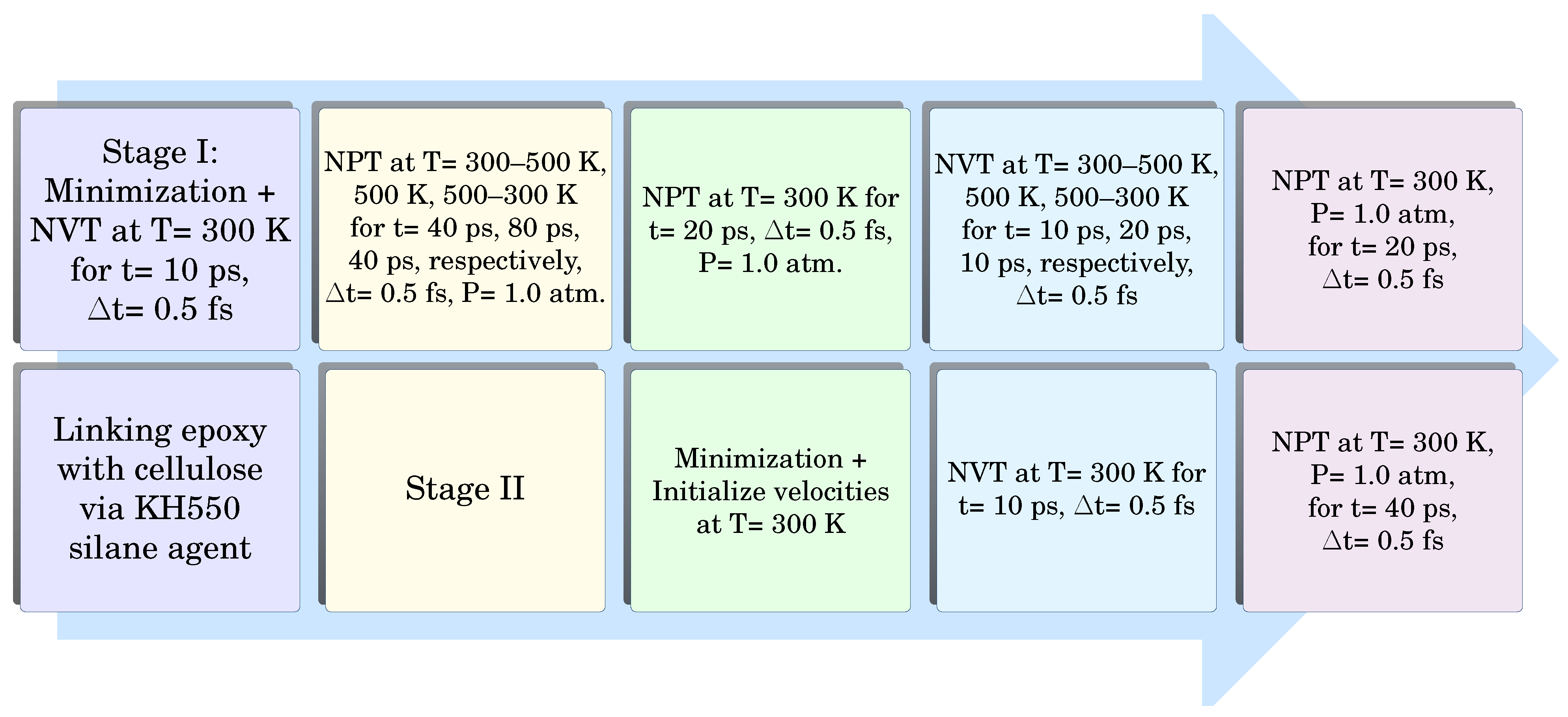
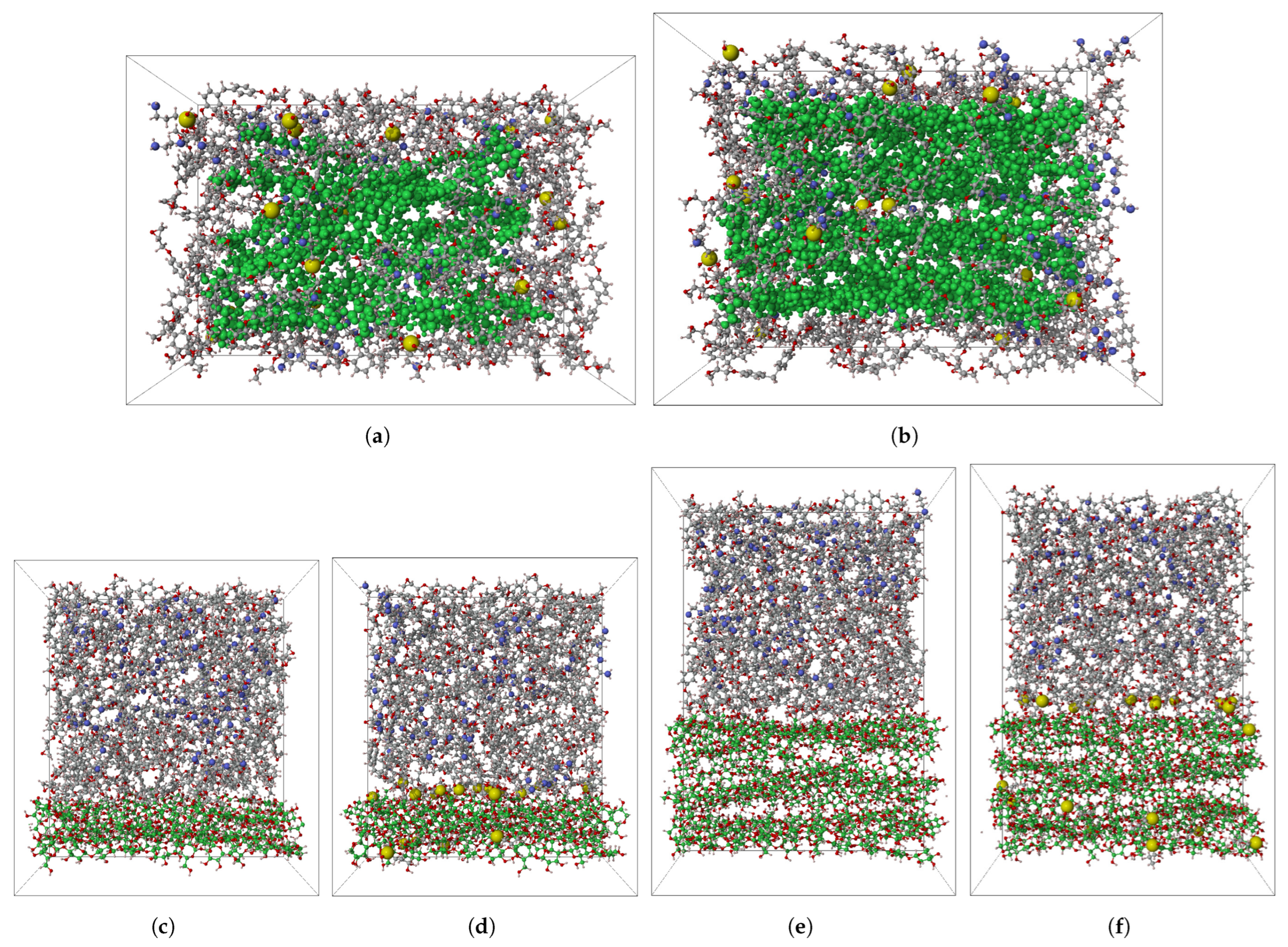
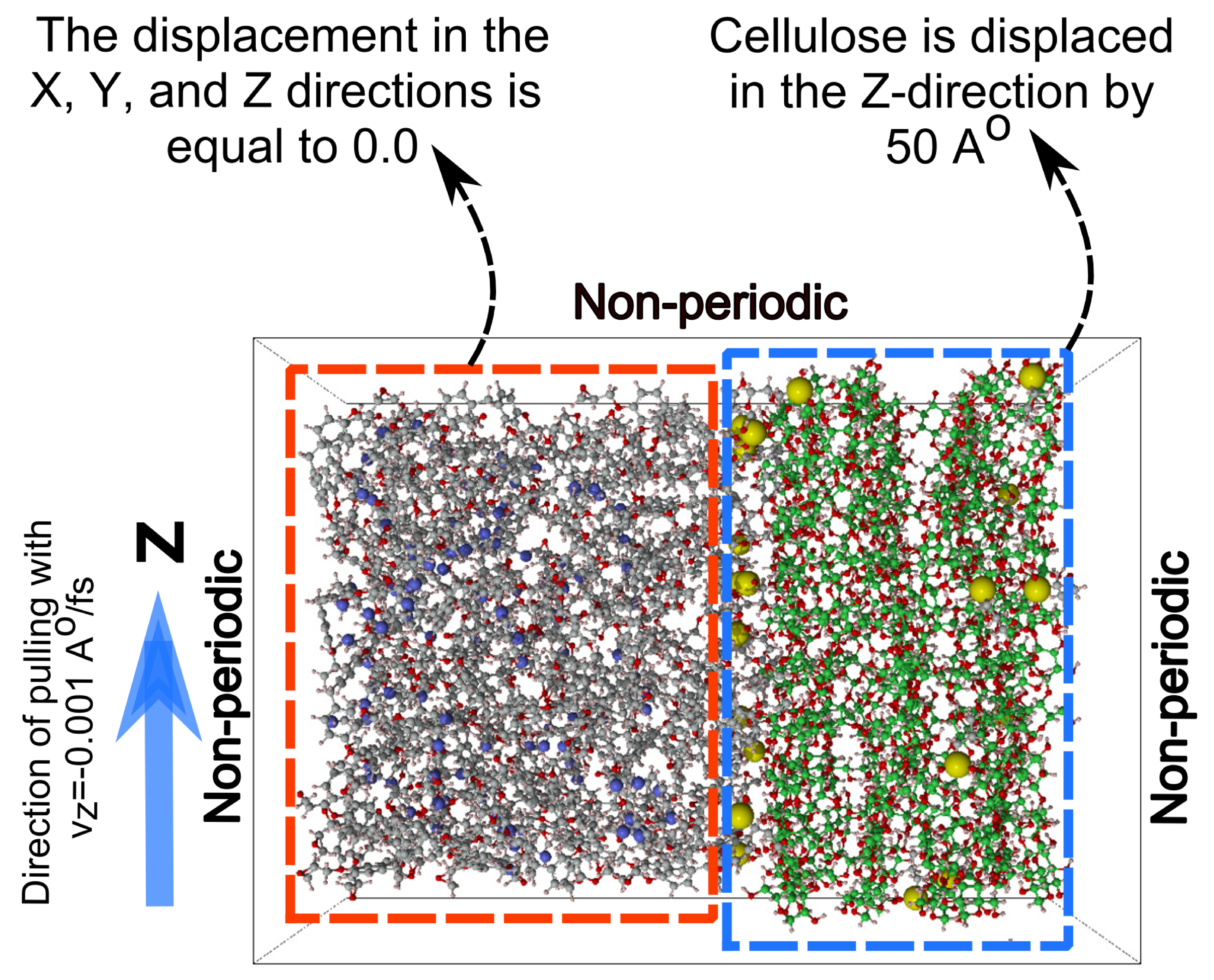
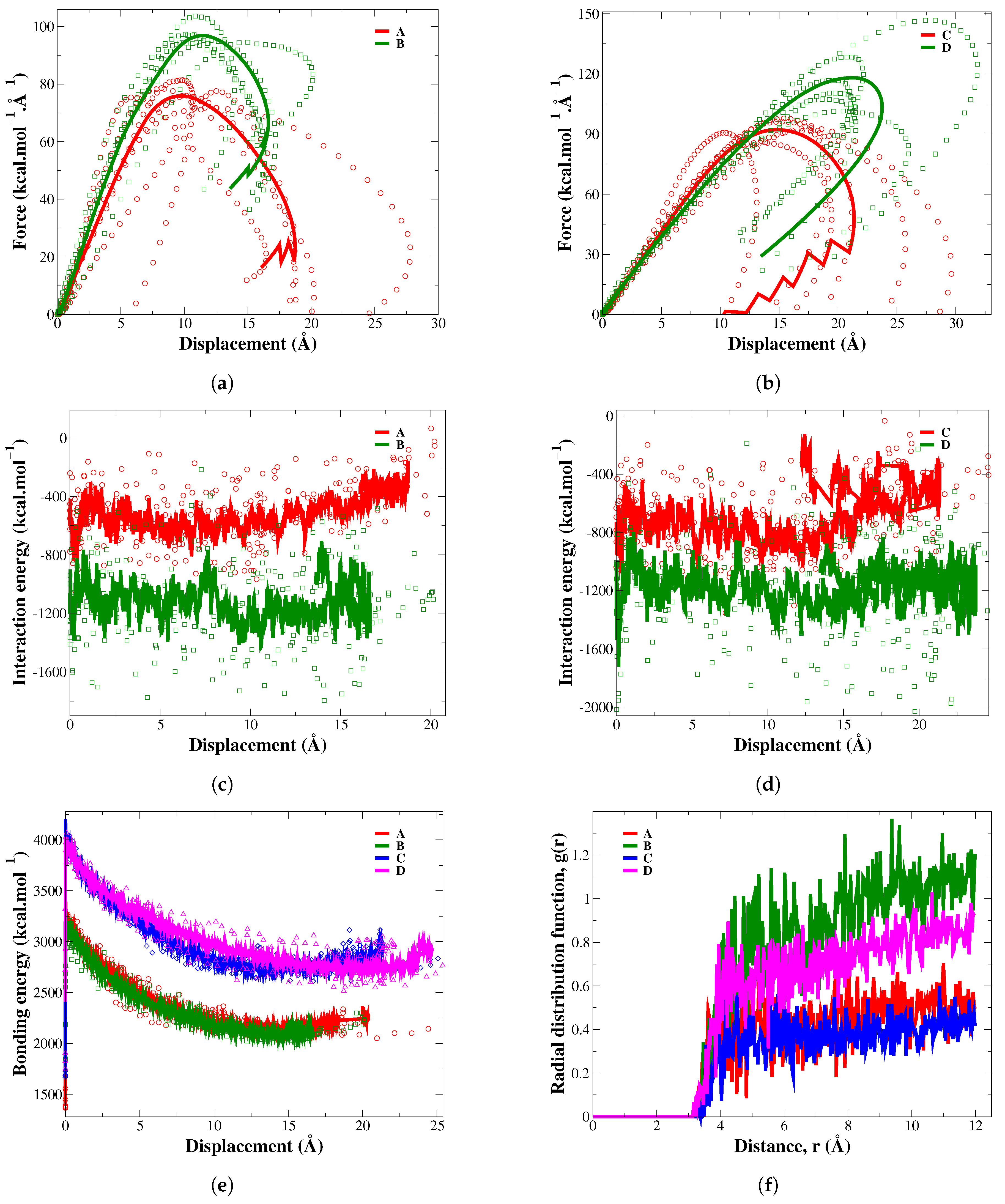
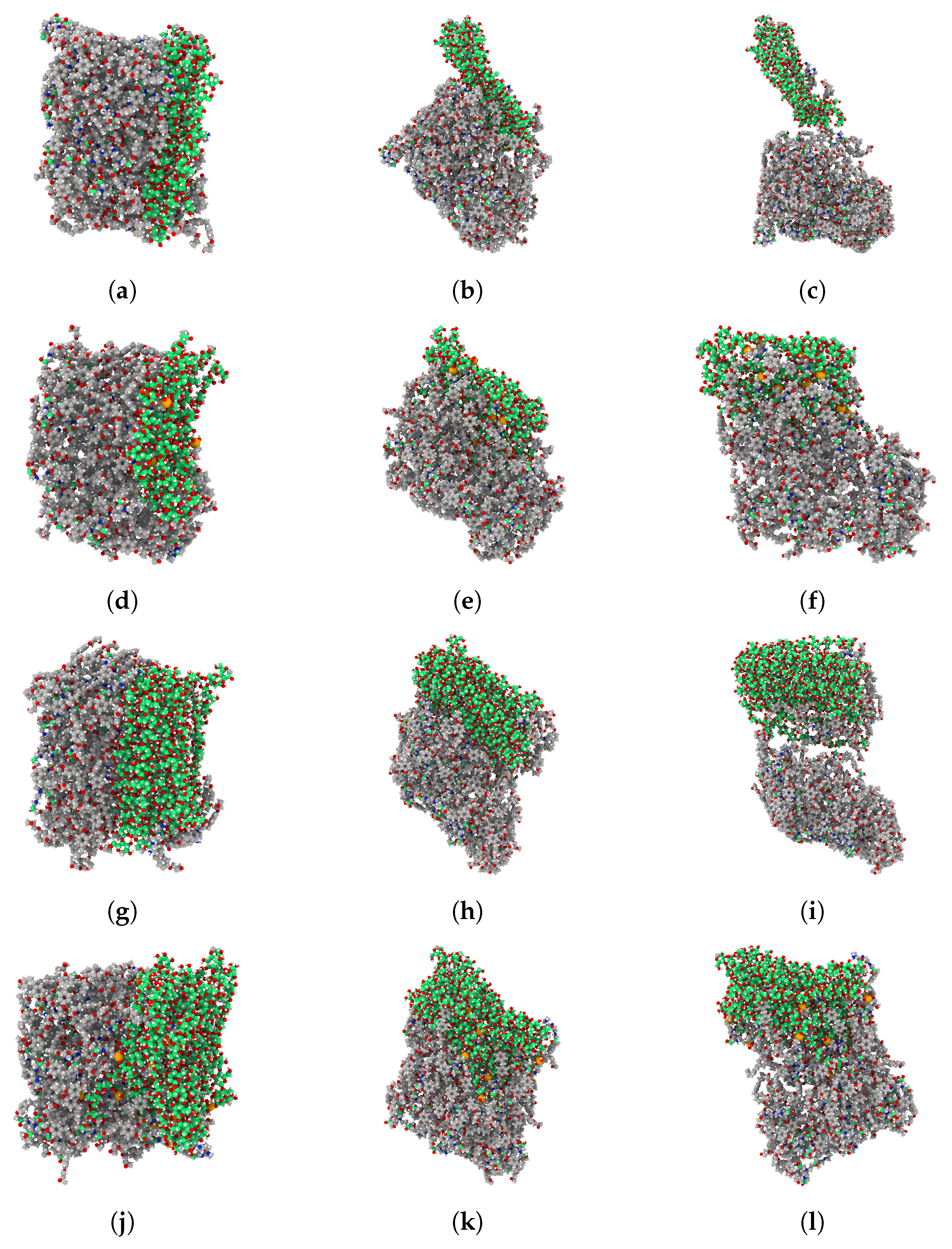
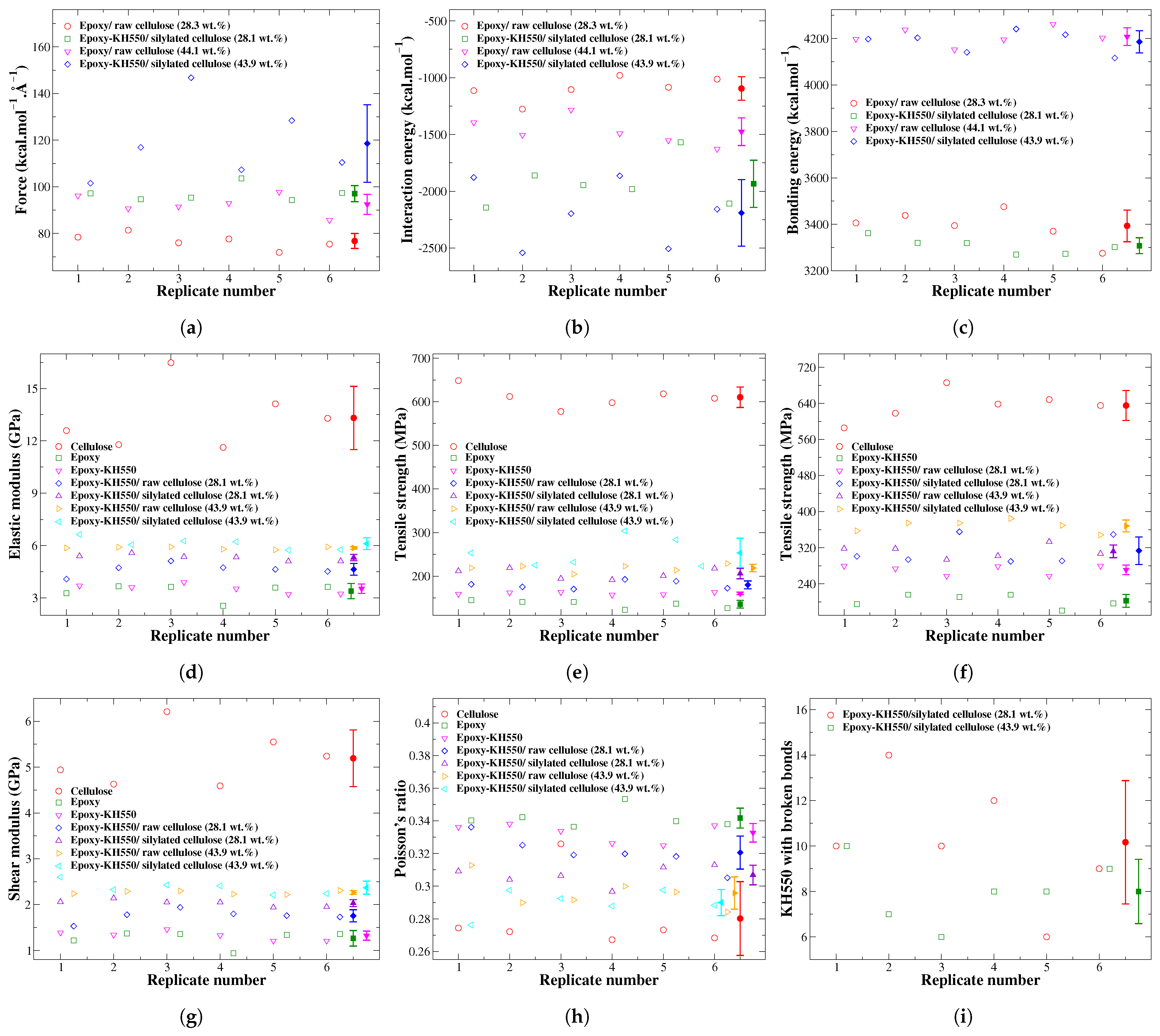
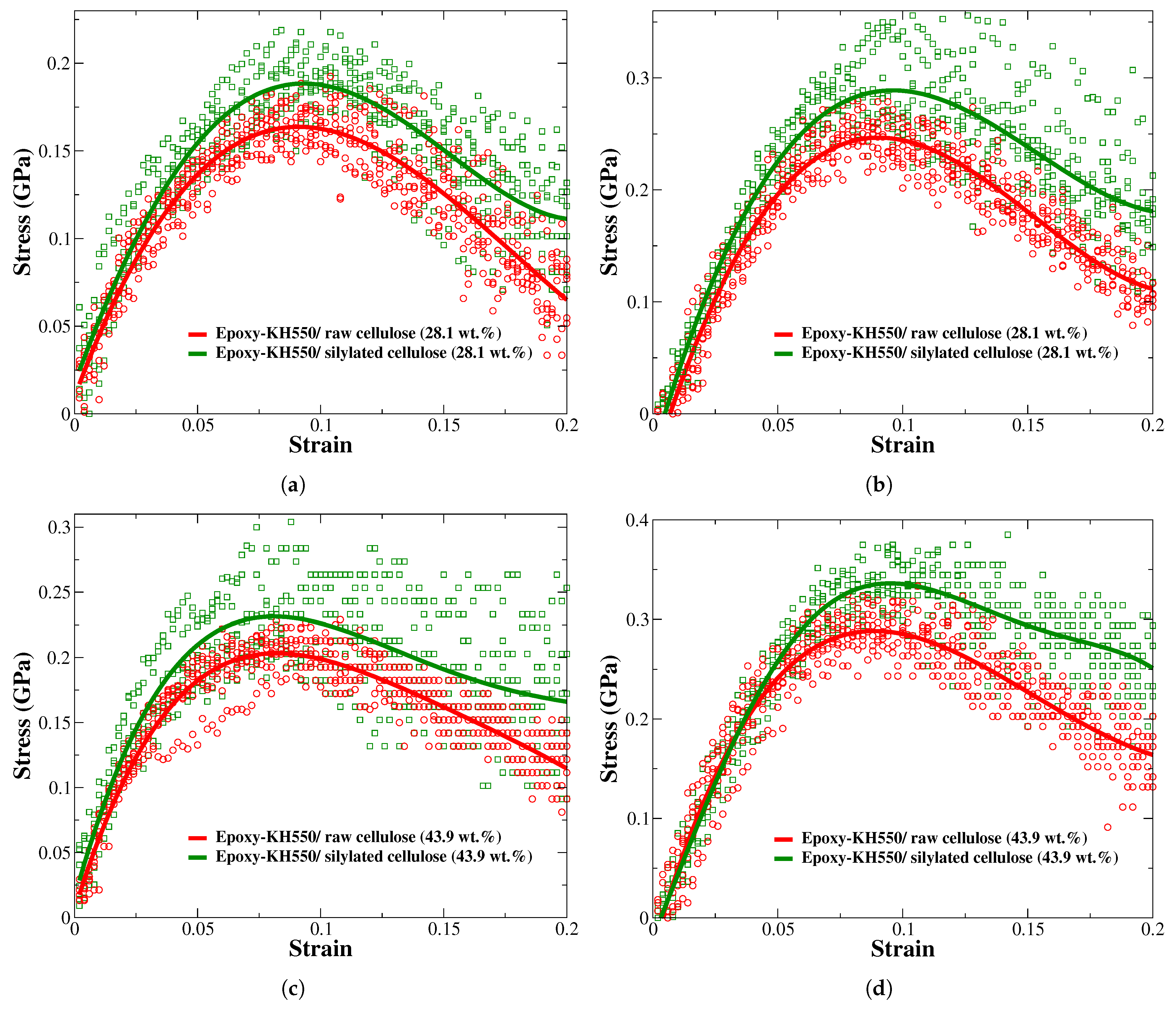
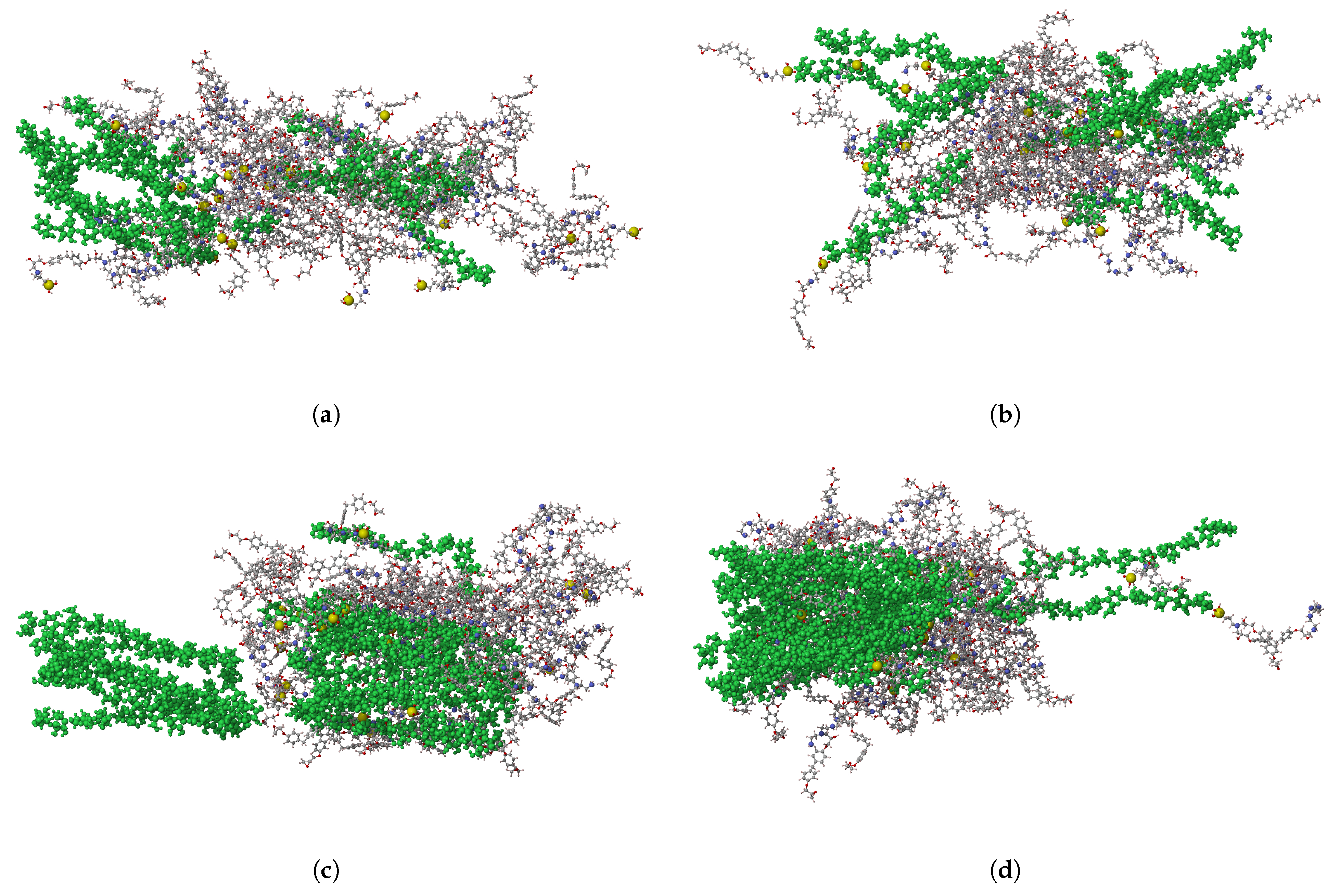
| Material | Molecular Formula | Matrix Composition | Cellulose (wt.%) | Number of Atoms |
|---|---|---|---|---|
| Cellulose | Cellulose chains: 20 | - | 4240 | |
| Epoxy | Diglycidyl ether bisphenol F molecules: 114, TETA molecules: 38 | - | 5966 | |
| Epoxy/cellulose (28.3 wt.%) | 28.3 | 8086 | ||
| Epoxy/cellulose (44.1 wt.%) | 44.1 | 10,206 | ||
| Epoxy-KH550 | Diglycidyl ether bisphenol F molecules: 110, TETA molecules: 30, KH550 molecules: 20 | - | 5950 | |
| Epoxy-KH550/cellulose (28.1 wt.%) | 28.1 | 8050 | ||
| Epoxy-KH550/cellulose (43.9 wt.%) | 43.9 | 10,170 |
| Material | Pulling Force (kcal··) | Interaction Energy (kcal·) | Bonding Energy (kcal·) |
|---|---|---|---|
| Epoxy/raw cellulose (28.3 wt.%) | 77 ± 3 | −1095 ± 109 | 3393 ± 72 |
| Epoxy-KH550/silylated cellulose (28.1 wt.%) | 97 ± 4 | −1934 ± 218 | 3308 ± 36 |
| Epoxy/raw cellulose (44.1 wt.%) | 93 ± 5 | −1476 ± 128 | 4208 ± 40 |
| Epoxy-KH550/silylated cellulose (43.9 wt.%) | 119 ± 17 | −2191 ± 307 | 4186 ± 50 |
| Material | Elasticity (GPa) | Strength, ReaxFF (MPa) | Strength (MPa) | Shear Modulus (GPa) | Poisson’s Ratio |
|---|---|---|---|---|---|
| Cellulose | 13.31 ± 1.90 | 635 ± 35 | 610 ± 25 | 5.19 ± 0.65 | 0.28 ± 0.02 |
| Epoxy-KH550 | 3.53 ± 0.28 | 202 ± 15 | 160 ± 3 | 1.32 ± 0.10 | 0.33 ± 0.01 |
| Epoxy-KH550/raw cellulose (28.1 wt.%) | 4.64 ± 0.36 | 271 ± 11 | 180 ± 10 | 1.76 ± 0.14 | 0.32 ± 0.01 |
| Epoxy-KH550/silylated cellulose (28.1 wt.%) | 5.31 ± 0.19 | 313 ± 32 | 206 ± 13 | 2.03 ± 0.08 | 0.31 ± 0.01 |
| Epoxy-KH550/raw cellulose (43.9 wt.%) | 5.87 ± 0.08 | 312 ± 15 | 219 ± 9 | 2.27 ± 0.04 | 0.30 ± 0.01 |
| Epoxy-KH550/silylated cellulose (43.9 wt.%) | 6.12 ± 0.36 | 369 ± 14 | 254 ± 35 | 2.37 ± 0.15 | 0.29 ± 0.01 |
Disclaimer/Publisher’s Note: The statements, opinions and data contained in all publications are solely those of the individual author(s) and contributor(s) and not of MDPI and/or the editor(s). MDPI and/or the editor(s) disclaim responsibility for any injury to people or property resulting from any ideas, methods, instructions or products referred to in the content. |
© 2025 by the authors. Licensee MDPI, Basel, Switzerland. This article is an open access article distributed under the terms and conditions of the Creative Commons Attribution (CC BY) license (https://creativecommons.org/licenses/by/4.0/).
Share and Cite
Al-Maharma, A.Y.; Markert, B.; Bamer, F. The Cellulose Loading and Silylation Effects on the Mechanical Properties of Epoxy Composites: Insights from Classical and Reactive Molecular Dynamics Simulations. Polymers 2025, 17, 2749. https://doi.org/10.3390/polym17202749
Al-Maharma AY, Markert B, Bamer F. The Cellulose Loading and Silylation Effects on the Mechanical Properties of Epoxy Composites: Insights from Classical and Reactive Molecular Dynamics Simulations. Polymers. 2025; 17(20):2749. https://doi.org/10.3390/polym17202749
Chicago/Turabian StyleAl-Maharma, Ahmad Y., Bernd Markert, and Franz Bamer. 2025. "The Cellulose Loading and Silylation Effects on the Mechanical Properties of Epoxy Composites: Insights from Classical and Reactive Molecular Dynamics Simulations" Polymers 17, no. 20: 2749. https://doi.org/10.3390/polym17202749
APA StyleAl-Maharma, A. Y., Markert, B., & Bamer, F. (2025). The Cellulose Loading and Silylation Effects on the Mechanical Properties of Epoxy Composites: Insights from Classical and Reactive Molecular Dynamics Simulations. Polymers, 17(20), 2749. https://doi.org/10.3390/polym17202749









